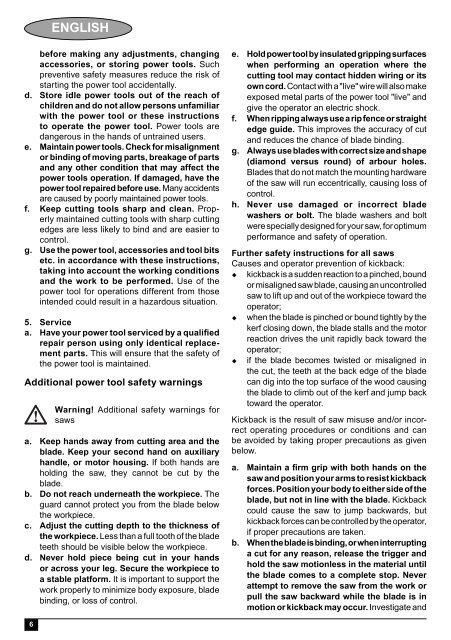BlackandDecker Sega Circolare- Cd601 - Type 2 - Instruction Manual (Europeo Orientale)
BlackandDecker Sega Circolare- Cd601 - Type 2 - Instruction Manual (Europeo Orientale)
BlackandDecker Sega Circolare- Cd601 - Type 2 - Instruction Manual (Europeo Orientale)
Create successful ePaper yourself
Turn your PDF publications into a flip-book with our unique Google optimized e-Paper software.
ENGLISH<br />
before making any adjustments, changing<br />
accessories, or storing power tools. Such<br />
preventive safety measures reduce the risk of<br />
starting the power tool accidentally.<br />
d. Store idle power tools out of the reach of<br />
children and do not allow persons unfamiliar<br />
with the power tool or these instructions<br />
to operate the power tool. Power tools are<br />
dangerous in the hands of untrained users.<br />
e. Maintain power tools. Check for misalignment<br />
or binding of moving parts, breakage of parts<br />
and any other condition that may affect the<br />
power tools operation. If damaged, have the<br />
power tool repaired before use. Many accidents<br />
are caused by poorly maintained power tools.<br />
f. Keep cutting tools sharp and clean. Properly<br />
maintained cutting tools with sharp cutting<br />
edges are less likely to bind and are easier to<br />
control.<br />
g. Use the power tool, accessories and tool bits<br />
etc. in accordance with these instructions,<br />
taking into account the working conditions<br />
and the work to be performed. Use of the<br />
power tool for operations different from those<br />
intended could result in a hazardous situation.<br />
5. Service<br />
a. Have your power tool serviced by a qualified<br />
repair person using only identical replacement<br />
parts. This will ensure that the safety of<br />
the power tool is maintained.<br />
Additional power tool safety warnings<br />
Warning! Additional safety warnings for<br />
saws<br />
a. Keep hands away from cutting area and the<br />
blade. Keep your second hand on auxiliary<br />
handle, or motor housing. If both hands are<br />
holding the saw, they cannot be cut by the<br />
blade.<br />
b. Do not reach underneath the workpiece. The<br />
guard cannot protect you from the blade below<br />
the workpiece.<br />
c. Adjust the cutting depth to the thickness of<br />
the workpiece. Less than a full tooth of the blade<br />
teeth should be visible below the workpiece.<br />
d. Never hold piece being cut in your hands<br />
or across your leg. Secure the workpiece to<br />
a stable platform. It is important to support the<br />
work properly to minimize body exposure, blade<br />
binding, or loss of control.<br />
e. Hold power tool by insulated gripping surfaces<br />
when performing an operation where the<br />
cutting tool may contact hidden wiring or its<br />
own cord. Contact with a "live" wire will also make<br />
exposed metal parts of the power tool "live" and<br />
give the operator an electric shock.<br />
f. When ripping always use a rip fence or straight<br />
edge guide. This improves the accuracy of cut<br />
and reduces the chance of blade binding.<br />
g. Always use blades with correct size and shape<br />
(diamond versus round) of arbour holes.<br />
Blades that do not match the mounting hardware<br />
of the saw will run eccentrically, causing loss of<br />
control.<br />
h. Never use damaged or incorrect blade<br />
washers or bolt. The blade washers and bolt<br />
were specially designed for your saw, for optimum<br />
performance and safety of operation.<br />
Further safety instructions for all saws<br />
Causes and operator prevention of kickback:<br />
kickback is a sudden reaction to a pinched, bound<br />
or misaligned saw blade, causing an uncontrolled<br />
saw to lift up and out of the workpiece toward the<br />
operator;<br />
when the blade is pinched or bound tightly by the<br />
kerf closing down, the blade stalls and the motor<br />
reaction drives the unit rapidly back toward the<br />
operator;<br />
if the blade becomes twisted or misaligned in<br />
the cut, the teeth at the back edge of the blade<br />
can dig into the top surface of the wood causing<br />
the blade to climb out of the kerf and jump back<br />
toward the operator.<br />
Kickback is the result of saw misuse and/or incorrect<br />
operating procedures or conditions and can<br />
be avoided by taking proper precautions as given<br />
below.<br />
a. Maintain a firm grip with both hands on the<br />
saw and position your arms to resist kickback<br />
forces. Position your body to either side of the<br />
blade, but not in line with the blade. Kickback<br />
could cause the saw to jump backwards, but<br />
kickback forces can be controlled by the operator,<br />
if proper precautions are taken.<br />
b. When the blade is binding, or when interrupting<br />
a cut for any reason, release the trigger and<br />
hold the saw motionless in the material until<br />
the blade comes to a complete stop. Never<br />
attempt to remove the saw from the work or<br />
pull the saw backward while the blade is in<br />
motion or kickback may occur. Investigate and<br />
6
















